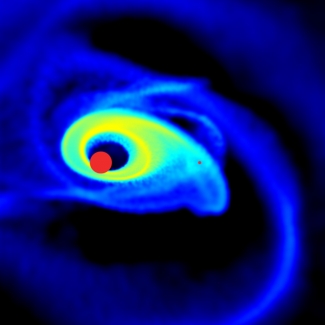A Be star is a luminous, blue B-type star with distinctive spectral lines that can provide two types of feasts (tasty snacks or full-scale banquets) for a former companion star in a binary system. The feasting begins when the companion star goes supernova and becomes a neutron star or, more rarely, a black hole. Typically, the companion blows up with enough force to kick itself into an eccentric (elliptical) orbit that is misaligned with respect to the Be star’s orbit.
Such skewed orbits, in particular their misalignment, help determine what kind of feast the surviving Be star delivers at any given time. The other factor at play is the intrinsic nature of the Be star itself. Be stars are among the most massive of stars. They are so large and rapidly spinning, in fact, that they spontaneously lose mass and form decretion disks in orbit around them.
Every time the neutron star makes a close approach to the Be star’s decretion disk, it enjoys a delicious snack of stardust. The neutron star belches outbursts of X-rays in appreciation. Astrophysicists call these emissions Type I X-ray outbursts. Type I X-ray outbursts can occur during every orbit of a neutron star around a Be star.
However, much less frequently, something different occurs. According to new theoretical work by the Armitage group and colleagues at JILA and elsewhere, the decretion disk around the Be star becomes so eccentric and misaligned that the neutron star is able to grab a whole lot of stardust from the Be star’s decretion disk. In fact, the neutron star steals so much of the Be star’s disk that an accretion disk forms around neutron star, as shown in the picture. The neutron star feasts off its newly formed accretion disk for weeks or even months, belching X-rays the entire time. Astrophysicists refer to these extended events as giant (Type II) outbursts.
Type II outbursts (i.e., full-scale banquets) can only occur when the Be star’s disk is both misaligned with the orbit of its companion and eccentric. The researchers responsible for clarifying the alimentary behavior of B star/X-ray binaries include research associates Rebecca Martin and Chris Nixon, Fellow Phil Armitage, and their colleagues from the Space Telescope Science Institute in Maryland and Monash University in Australia.—Julie Phillips




